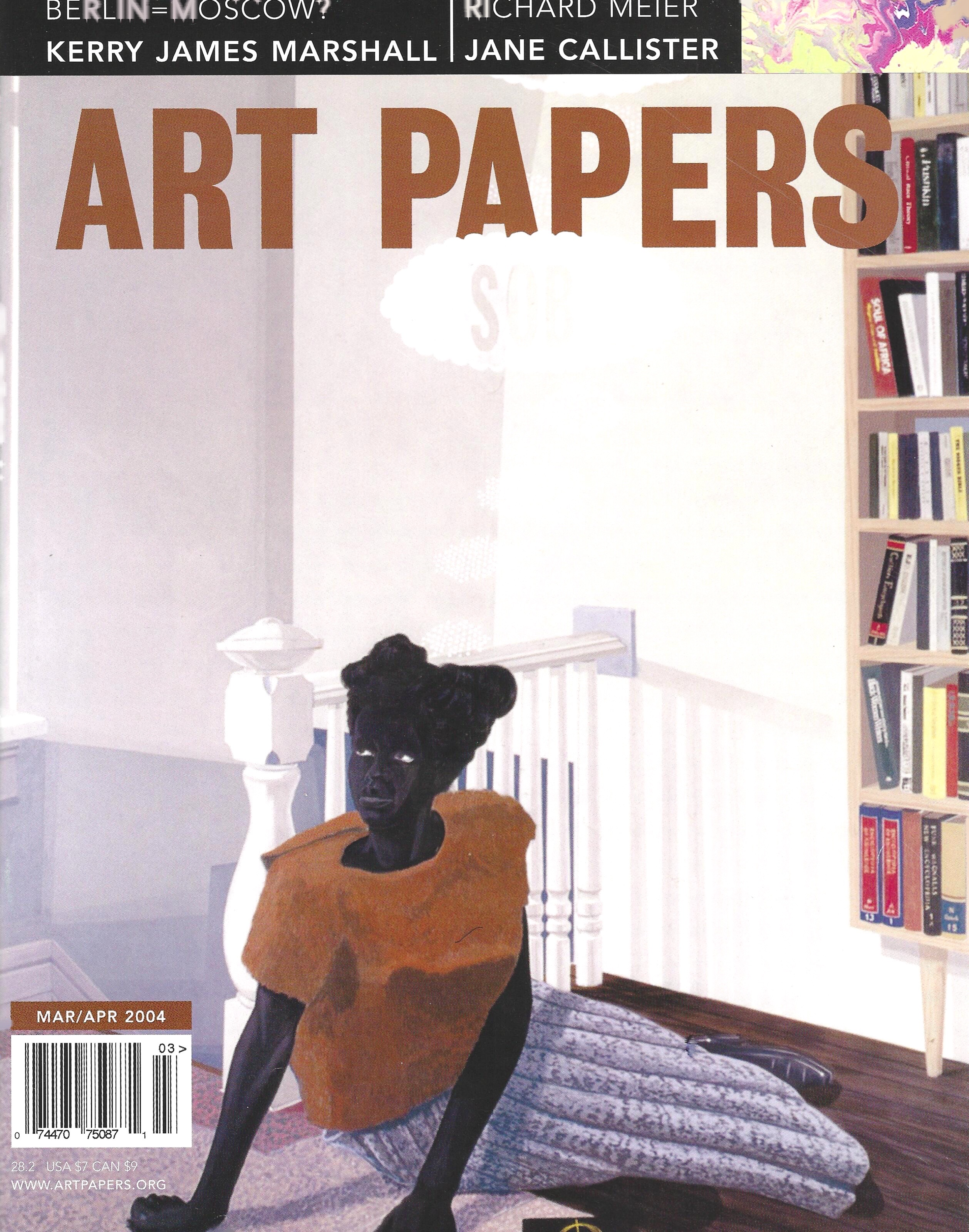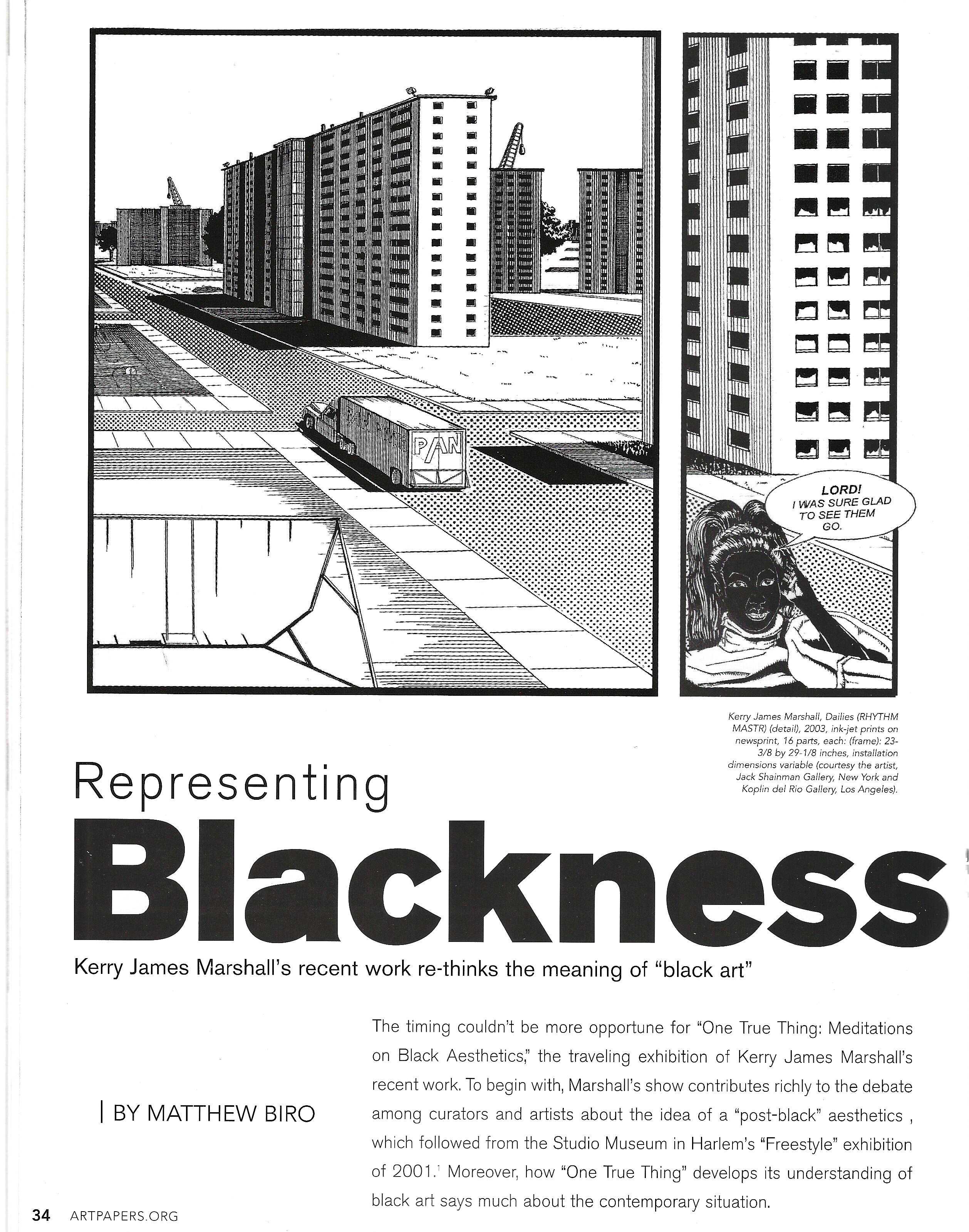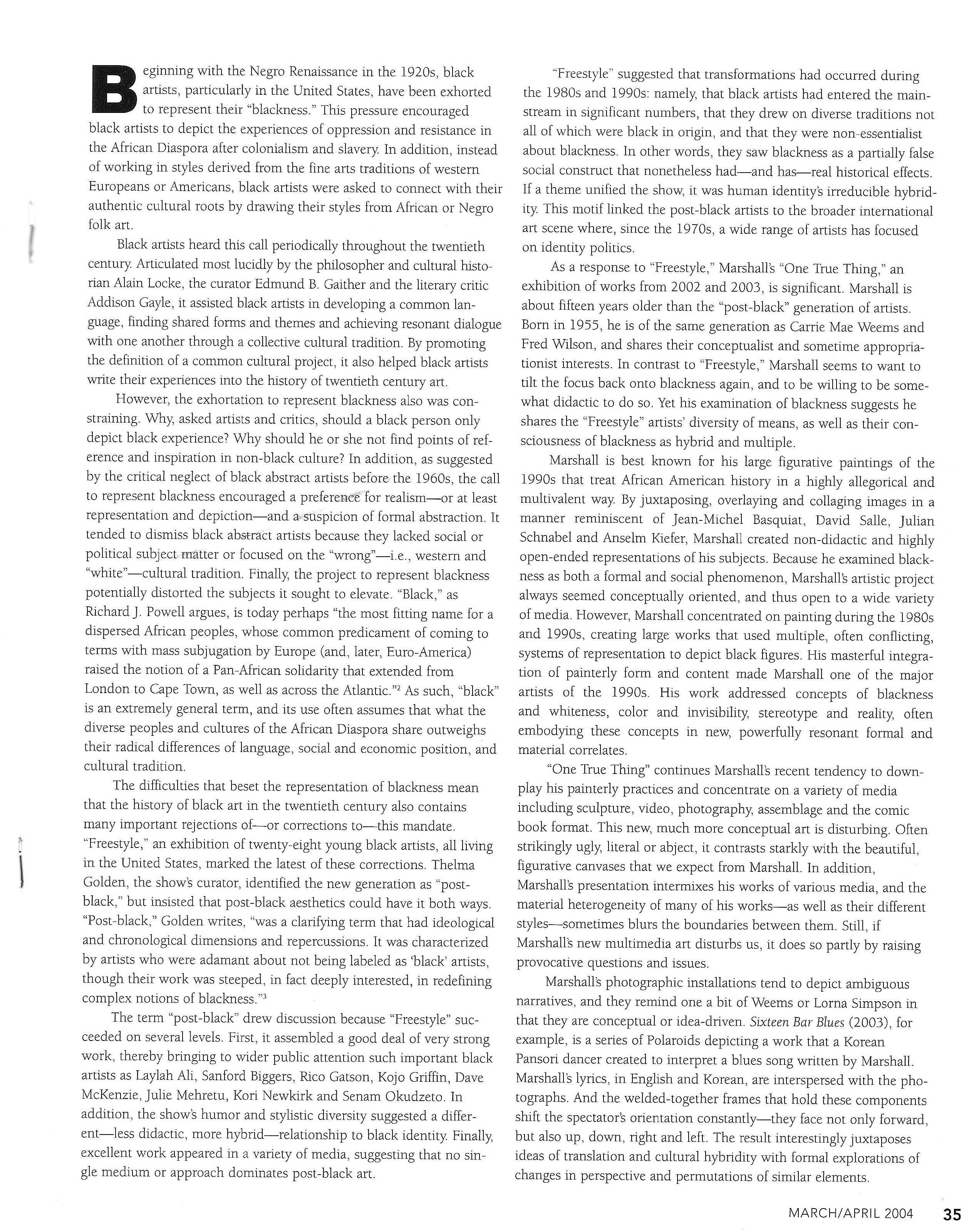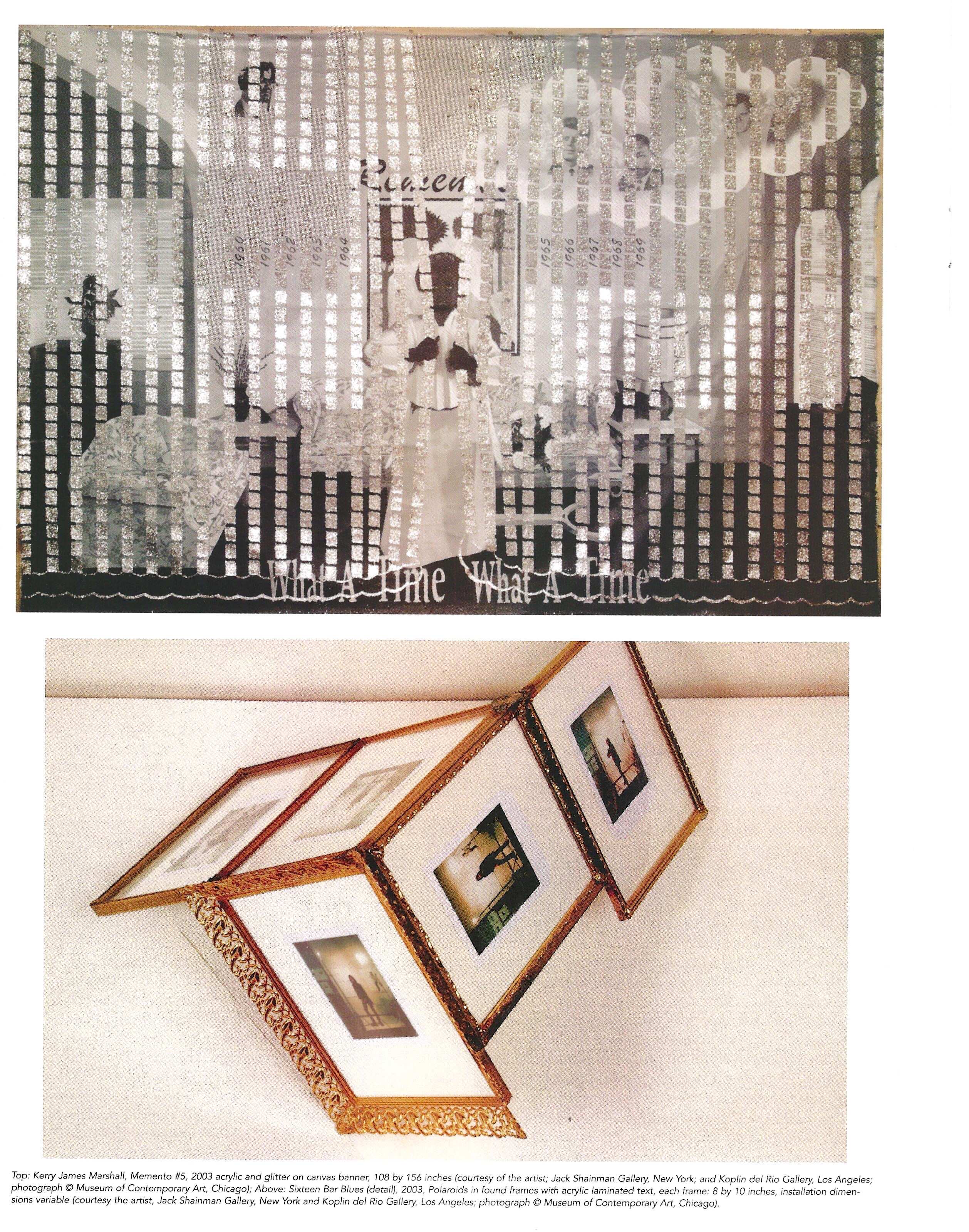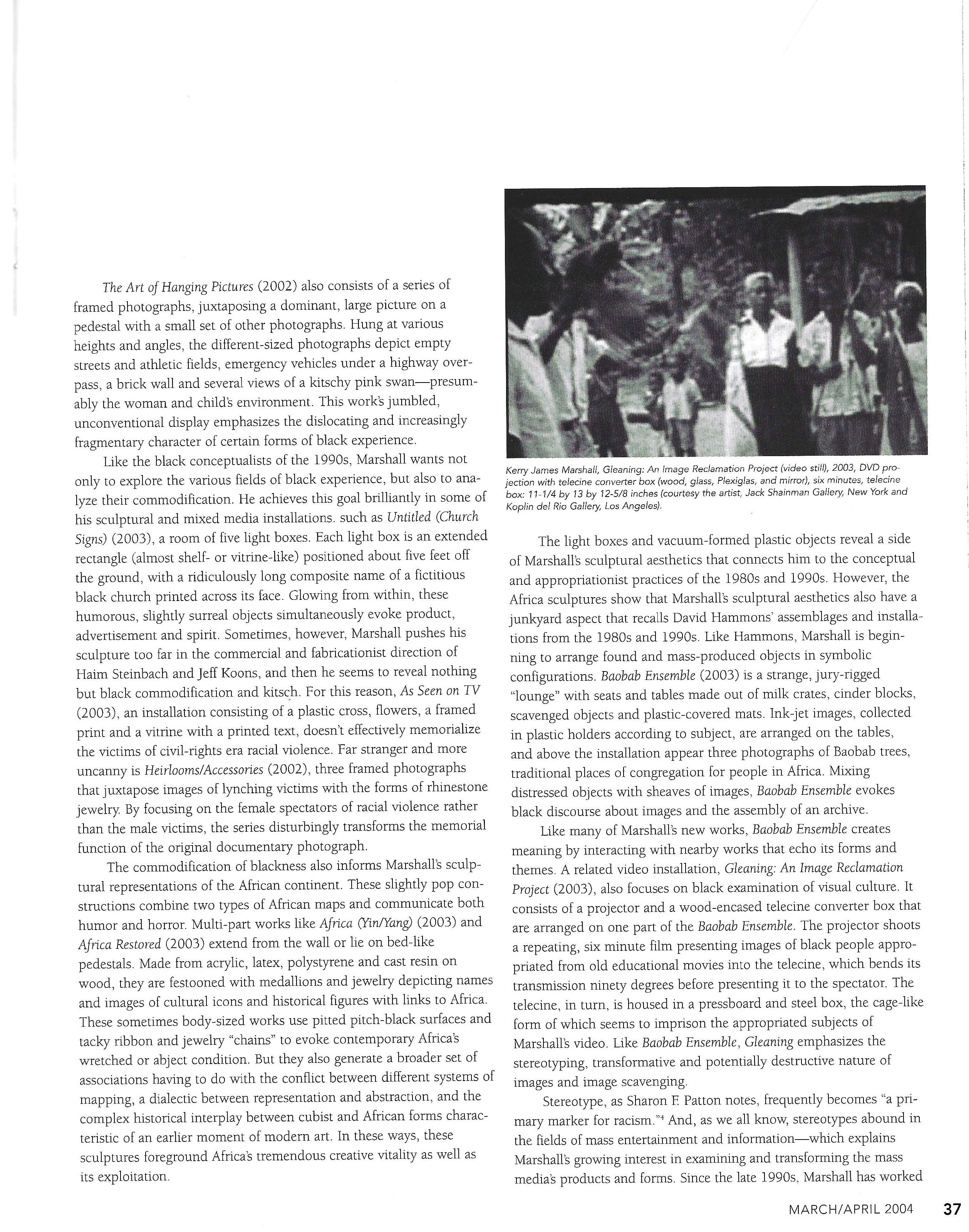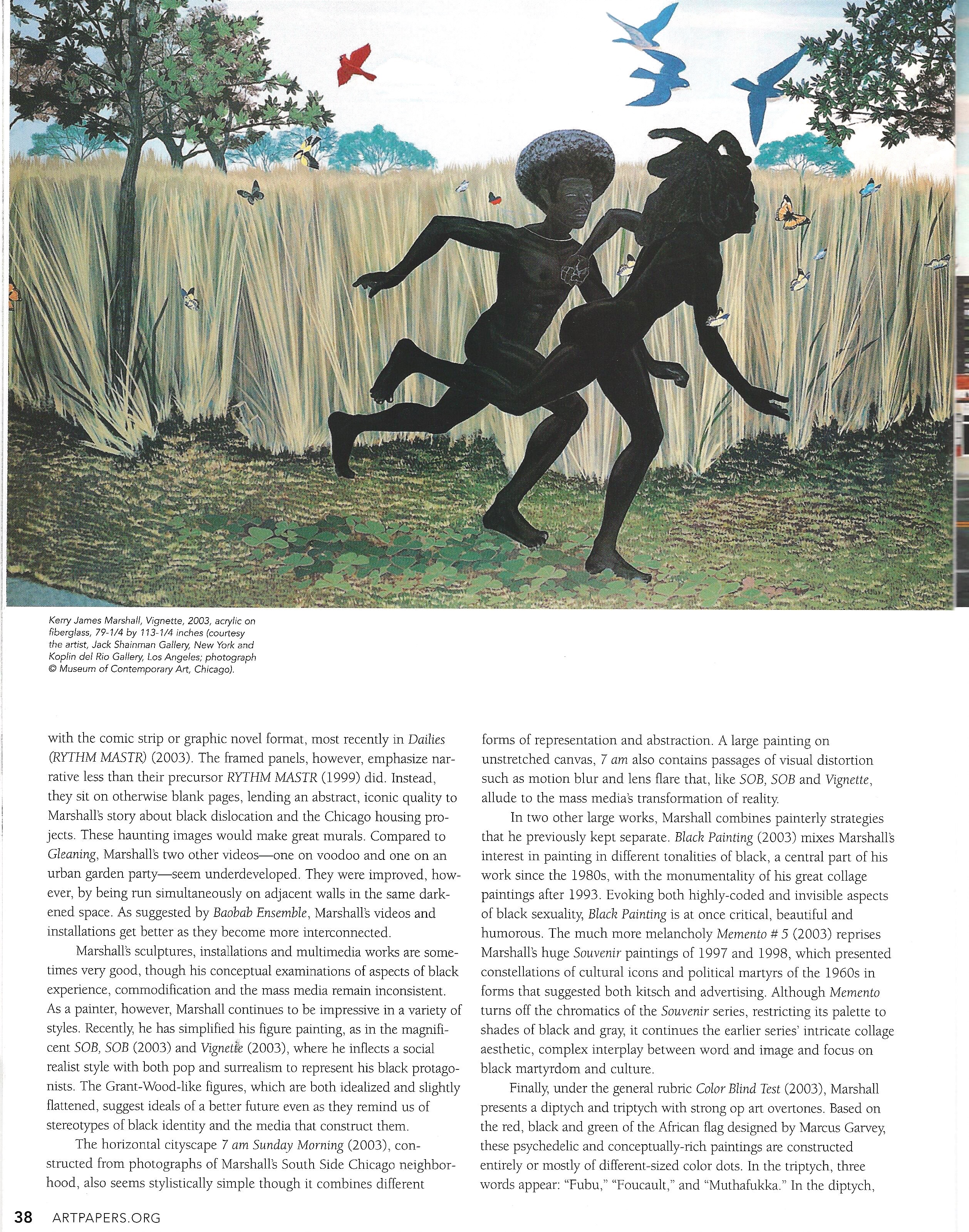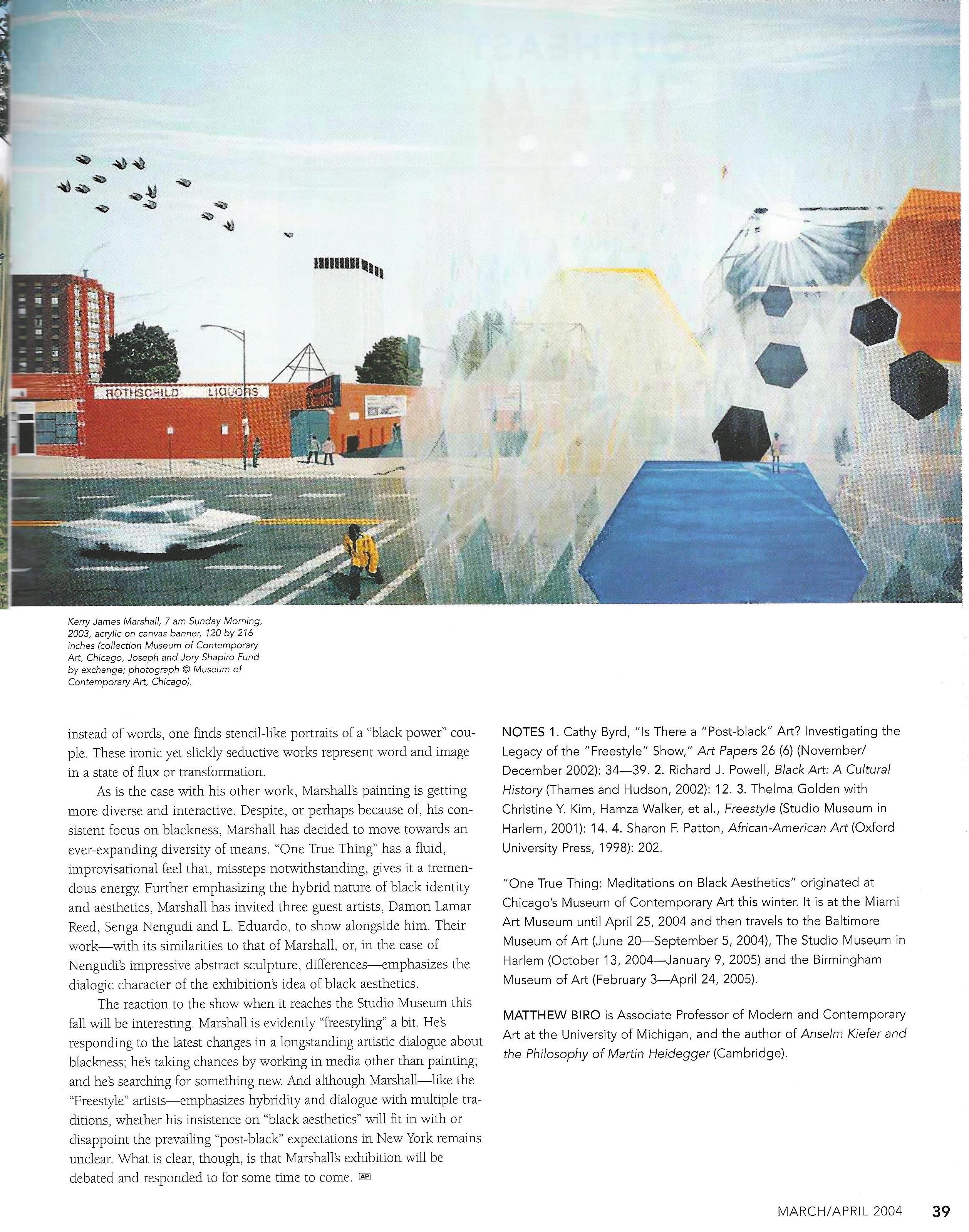Representing Blackness
Kerry James Marshall in situ on issue 28.02 of Art Papers, originally published March/April 2004. Cover: Kerry James Marshall, SOB,SOB (detail), 2003, acrylic on fiberglass in artist’s wood frame, 113.25 x 79.25 inches (courtesy of the artist and Jack Shainman Gallery)
Share:
This essay was originally published in ART PAPERS March/April 2004, Vol 28, issue 2.
The timing couldn’t be more opportune for “One True Thing: Meditations on Black Aesthetics,” the traveling exhibition of Kerry James Marshall’s recent work. To begin with, Marshall’s show contributes richly to the debate among curators and artists about the idea of a “post-black” aesthetics, which followed from the Studio Museum in Harlem’s “Freestyle” exhibition of 2001.1 Moreover, how “One True Thing” develops its understanding of black art says much about the contemporary situation
Beginning with the [Harlem] Renaissance in the 1920s, black artists, particularly in the United States, have been exhorted to represent their “blackness.” This pressure encouraged black artists to depict the experiences of oppression and resistance in the African Diaspora after colonialism and slavery. In addition, instead of working in styles derived from the fine arts traditions of western Europeans or Americans, black artists were asked to connect with their authentic cultural roots by drawing their styles from African or Negro [sic] folk art.
Black artists heard this call periodically throughout the twentieth century. Articulated most lucidly by the philosopher and cultural historian Alain Locke, the curator Edmund B. Gaither and the literary critic Addison Gayle, it assisted black artists in developing a common language, finding shared forms and themes and achieving resonant dialogue with one another through a collective cultural tradition. By promoting the definition of a common cultural project, it also helped black artists write their experiences into the history of twentieth century art.
However, the exhortation to represent blackness also was constraining. Why, asked artists and critics, should a black person only depict black experience? Why should he or she not find points of reference and inspiration in non-black culture? In addition, as suggested by the critical neglect of black abstract artists before the 1960s, the call to represent blackness encouraged a preference for realism—or at least representation and depiction—and a suspicion of formal abstraction. It tended to dismiss black abstract artists because they lacked social or political subject matter or focused on the “wrong”—i.e., western and “white”—cultural tradition. Finally, the project to represent blackness potentially distorted the subjects it sought to elevate. “Black,” as Richard J. Powell argues, is today perhaps “the most fitting name for a dispersed African peoples, whose common predicament of coming to terms with mass subjugation by Europe (and, later, Euro-America) raised the notion of a Pan-African solidarity that extended from London to Cape Town, as well as across the Atlantic.”2 As such, “black” is an extremely general term, and its use often assumes that what the diverse peoples and cultures of the African Diaspora share outweighs their radical differences of language, social and economic position, and cultural tradition.
The difficulties that beset the representation of blackness mean that the history of black art in the twentieth century also contains many important rejections of or corrections to this mandate. “Freestyle,” an exhibition of twenty-eight young black artists, all living in the United States, marked the latest of these corrections. Thelma Golden, the show’s curator, identified the new generation as “post- black,” but insisted that post-black aesthetics could have it both ways. “Post-black,” Golden writes, “was a clarifying term that had ideological and chronological dimensions and repercussions. It was characterized by artists who were adamant about not being labeled as ‘black’ artists, though their work was steeped, in fact deeply interested, in redefining complex notions of blackness.”3
The term “post-black” drew discussion because “Freestyle” succeeded on several levels. First, it assembled a good deal of very strong work, thereby bringing to wider public attention such important black artists as Laylah Ali, Sanford Biggers, Rico Gatson, Kojo Griffin, Dave McKenzie, Julie Mehretu, Kori Newkirk and Senam Okudzeto. In addition, the show’s humor and stylistic diversity suggested a different—less didactic, more hybrid-relationship to black identity. Finally, excellent work appeared in a variety of media, suggesting that no single medium or approach dominates post-black art.
“Freestyle” suggested that transformations had occurred during the 1980s and 1990s: namely, that black artists had entered the mainstream in significant numbers, that they drew on diverse traditions not all of which were black in origin, and that they were non-essentialist about blackness. In other words, they saw blackness as a partially false social construct that nonetheless had—and has—real historical effects. If a theme unified the show, it was human identity’s irreducible hybridity. This motif linked the post-black artists to the broader international art scene where, since the 1970s, a wide range of artists has focused on identity politics.
As a response to “Freestyle,” Marshall’s “One True Thing,” an exhibition of works from 2002 and 2003, is significant. Marshall is about fifteen years older than the “post-black” generation of artists. Born in 1955, he is of the same generation as Carrie Mae Weems and Fred Wilson, and shares their conceptualist and sometime appropriationist interests. In contrast to “Freestyle,” Marshall seems to want to tilt the focus back onto blackness again, and to be willing to be somewhat didactic to do so. Yet his examination of blackness suggests he shares the “Freestyle” artists’ diversity of means, as well as their consciousness of blackness as hybrid and multiple.
Marshall is best known for his large figurative paintings of the 1990s that treat African American history in a highly allegorical and multivalent way. By juxtaposing, overlaying and collaging images in a manner reminiscent of Jean-Michel Basquiat, David Salle, Julian Schnabel and Anselm Kiefer, Marshall created non-didactic and highly open-ended representations of his subjects. Because he examined blackness as both a formal and social phenomenon, Marshall’s artistic project always seemed conceptually oriented, and thus open to a wide variety of media. However, Marshall concentrated on painting during the 1980s and 1990s, creating large works that used multiple, often conflicting, systems of representation to depict black figures. His masterful integration of painterly form and content made Marshall one of the major artists of the 1990s. His work addressed concepts of blackness and whiteness, color and invisibility, stereotype and reality, often embodying these concepts in new, powerfully resonant formal and material correlates.
“One True Thing” continues Marshall’s recent tendency to downplay his painterly practices and concentrate on a variety of media including sculpture, video, photography, assemblage and the comic book format. This new, much more conceptual art is disturbing. Often strikingly ugly, literal or abject, it contrasts starkly with the beautiful, figurative canvases that we expect from Marshall. In addition, Marshall’s presentation intermixes his works of various media, and the material heterogeneity of many of his works—as well as their different styles—sometimes blurs the boundaries between them. Still, if Marshall’s new multimedia art disturbs us, it does so partly by raising provocative questions and issues.
Marshall’s photographic installations tend to depict ambiguous narratives, and they remind one a bit of Weems or Lorna Simpson in that they are conceptual or idea-driven. Sixteen Bar Blues (2003), for example, is a series of Polaroids depicting a work that a Korean Pansori dancer created to interpret a blues song written by Marshall. Marshall’s lyrics, in English and Korean, are interspersed with the photographs. And the welded-together frames that hold these components shift the spectator’s orientation constantly—they face not only forward, but also up, down, right and left. The result interestingly juxtaposes ideas of translation and cultural hybridity with formal explorations of changes in perspective and permutations of similar elements.
The Art of Hanging Pictures (2002) also consists of a series of framed photographs, juxtaposing a dominant, large picture on a pedestal with a small set of other photographs. Hung at various heights and angles, the different-sized photographs depict empty streets and athletic fields, emergency vehicles under a highway overpass, a brick wall and several views of a kitschy pink swan—presumably the woman and child’s environment. This work’s jumbled, unconventional display emphasizes the dislocating and increasingly fragmentary character of certain forms of black experience.
Like the black conceptualists of the 1990s, Marshall wants not only to explore the various fields of black experience, but also to analyze their commodification. He achieves this goal brilliantly in some of his sculptural and mixed media installations, such as Untitled (Church Signs) (2003), a room of five light boxes. Each light box is an extended rectangle (almost shelf- or vitrine-like) positioned about five feet off the ground, with a ridiculously long composite name of a fictitious black church printed across its face. Glowing from within, these humorous, slightly surreal objects simultaneously evoke product, advertisement and spirit. Sometimes, however, Marshall pushes his sculpture too far in the commercial and fabricationist direction of Haim Steinbach and Jeff Koons, and then he seems to reveal nothing but black commodification and kitsch. For this reason, As Seen on TV (2003), an installation consisting of a plastic cross, flowers, a framed print and a vitrine with a printed text, doesn’t effectively memorialize the victims of civil-rights era racial violence. Far stranger and more uncanny is Heirlooms/Accessories (2002), three framed photographs that juxtapose images of lynching victims with the forms of rhinestone jewelry. By focusing on the female spectators of racial violence rather than the male victims, the series disturbingly transforms the memorial function of the original documentary photograph.
The commodification of blackness also informs Marshall’s sculptural representations of the African continent. These slightly pop constructions combine two types of African maps and communicate both humor and horror. Multi-part works like Africa (Yin/Yang) (2003) and Africa Restored (2003) extend from the wall or lie on bed-like pedestals. Made from acrylic, latex, polystyrene and cast resin on wood, they are festooned with medallions and jewelry depicting names and images of cultural icons and historical figures with links to Africa. These sometimes body-sized works use pitted pitch-black surfaces and tacky ribbon and jewelry “chains” to evoke contemporary Africa’s wretched or abject condition. But they also generate a broader set of associations having to do with the conflict between different systems of mapping, a dialectic between representation and abstraction, and the complex historical interplay between cubist and African forms characteristic of an earlier moment of modern art. In these ways, these sculptures foreground Africa’s tremendous creative vitality as well as its exploitation.
The light boxes and vacuum-formed plastic objects reveal a side of Marshall’s sculptural aesthetics that connects him to the conceptual and appropriationist practices of the 1980s and 1990s. However, the Africa sculptures show that Marshall’s sculptural aesthetics also have a junkyard aspect that recalls David Hammons’ assemblages and installations from the 1980s and 1990s. Like Hammons, Marshall is beginning to arrange found and mass-produced objects in symbolic configurations. Baobab Ensemble (2003) is a strange, jury-rigged “lounge” with seats and tables made out of milk crates, cinder blocks, scavenged objects and plastic-covered mats. Ink-jet images, collected in plastic holders according to subject, are arranged on the tables, and above the installation appear three photographs of Baobab trees, traditional places of congregation for people in Africa. Mixing distressed objects with sheaves of images, Baobab Ensemble evokes black discourse about images and the assembly of an archive.
Like many of Marshall’s new works, Baobab Ensemble creates meaning by interacting with nearby works that echo its forms and themes. A related video installation, Gleaning: An Image Reclamation Project (2003), also focuses on black examination of visual culture. It consists of a projector and a wood-encased telecine converter box that are arranged on one part of the Baobab Ensemble. The projector shoots a repeating, six minute film presenting images of black people appropriated from old educational movies into the telecine, which bends its transmission ninety degrees before presenting it to the spectator. The telecine, in turn, is housed in a pressboard and steel box, the cage-like form of which seems to imprison the appropriated subjects of Marshall’s video. Like Baobab Ensemble, Gleaning emphasizes the stereotyping, transformative and potentially destructive nature of images and image scavenging.
Stereotype, as Sharon F. Patton notes, frequently becomes “a primary marker for racism.”4 And, as we all know, stereotypes abound in the fields of mass entertainment and information which explains Marshall’s growing interest in examining and transforming the mass medias products and forms. Since the late 1990’s Marshall has worked with the comic strip or graphic novel format, most recently in Dailies (RYTHM MASTR) (2003). The framed panels, however, emphasize narrative less than their precursor RYTHM MASTR (1999) did. Instead, they sit on otherwise blank pages, lending an abstract, iconic quality to Marshall’s story about black dislocation and the Chicago housing projects. These haunting images would make great murals. Compared to Gleaning, Marshall’s two other videos—one on voodoo and one on an urban garden party—seem underdeveloped. They were improved, however, by being run simultaneously on adjacent walls in the same darkened space. As suggested by Baobab Ensemble, Marshall’s videos and installations get better as they become more interconnected.
Marshall’s sculptures, installations and multimedia works are sometimes very good, though his conceptual examinations of aspects of black experience, commodification and the mass media remain inconsistent. As a painter, however, Marshall continues to be impressive in a variety of styles. Recently, he has simplified his figure painting, as in the magnificent SOB, SOB (2003) and Vignette (2003), where he inflicts a social realist style with both pop and surrealism to represent his black protagonists. The Grant-Wood-like figures, which are both idealized and slightly flattened, suggest ideals of a better future even as they remind us of stereotypes of black identity and the media that construct them.
The horizontal cityscape 7 am Sunday Morning (2003), constructed from photographs of Marshall’s South Side Chicago neighborhood, also seems stylistically simple though it combines different forms of representation and abstraction. A large painting on unstretched canvas, 7 am also contains passages of visual distortion such as motion blur and lens flare that, like SOB, SOB and Vignette, allude to the mass media’s transformation of reality.
In two other large works, Marshall combines painterly strategies that he previously kept separate. Black Painting (2003) mixes Marshall’s interest in painting in different tonalities of black, a central part of his work since the 1980s, with the monumentality of his great collage paintings after 1993. Evoking both highly-coded and invisible aspects of black sexuality, Black Painting is at once critical, beautiful and humorous. The much more melancholy Memento #5 (2003) reprises Marshall’s huge Souvenir paintings of 1997 and 1998, which presented constellations of cultural icons and political martyrs of the 1960s in forms that suggested both kitsch and advertising. Although Memento turns off the chromatics of the Souvenir series, restricting its palette to shades of black and gray, it continues the earlier series’ intricate collage aesthetic, complex interplay between word and image and focus on black martyrdom and culture.
Finally, under the general rubric Color Blind Test (2003), Marshall presents a diptych and triptych with strong op art overtones. Based on the red, black and green of the African flag designed by Marcus Garvey, these psychedelic and conceptually-rich paintings are constructed entirely or mostly of different-sized color dots. In the triptych, three. words appear: “Fubu,” “Foucault,” and “Muthafukka.” In the diptych, instead of words, one finds stencil-like portraits of a “black power” couple. These ironic yet slickly seductive works represent word and image in a state of flux or transformation.
As is the case with his other work, Marshall’s painting is getting more diverse and interactive. Despite, or perhaps because of, his consistent focus on blackness, Marshall has decided to move towards an ever expanding diversity of means. “One True Thing” has a fluid, improvisational feel that, missteps notwithstanding, gives it a tremendous energy. Further emphasizing the hybrid nature of black identity and aesthetics, Marshall has invited three guest artists, Damon Lamar Reed, Senga Nengudi and L. Eduardo, to show alongside him. Their work with its similarities to that of Marshall, or, in the case of Nengudi’s impressive abstract sculpture, differences—emphasizes the dialogic character of the exhibition’s idea of black aesthetics.
The reaction to the show when it reaches the Studio Museum this fall will be interesting. Marshall is evidently “freestyling” a bit. He’s responding to the latest changes in a longstanding artistic dialogue about blackness; he’s taking chances by working in media other than painting; and he’s searching for something new. And although Marshall-like the “Freestyle” artists—emphasizes hybridity and dialogue with multiple traditions, whether his insistence on “black aesthetics” will fit in with or disappoint the prevailing “post-black” expectations in New York remains unclear. What is clear, though, is that Marshall’s exhibition will be debated and responded to for some time to come.
Matthew Biro is Professor of Modern and Contemporary Art in the Department of the History of Art at the University of Michigan, where he also served as department chair between 2010 and 2016. He is the author of Anselm Kiefer and the Philosophy of Martin Heidegger (1998), The Dada Cyborg: Visions of the New Human in Weimar Berlin (2009), Anselm Kiefer (2013), and Robert Heinecken and the Art of Appropriation (2022). His reviews of contemporary art, film, and photography have appeared in Artforum, Art in America, The Brooklyn Rail, Contemporary, Art Papers, and The New Art Examiner.
References
| ↑1 | Cathy Byrd, “Is There a “Post-black” Art? Investigating the Legacy of the “Freestyle” Show,” Art Papers 26 (6) (November/ December 2002): 34-39. |
|---|---|
| ↑2 | Richard J. Powell, Black Art: A Cultural History (Thames and Hudson, 2002): 12. |
| ↑3 | Thelma Golden with Christine Y. Kim, Hamza Walker, et al., Freestyle (Studio Museum in Harlem, 2001): 14. |
| ↑4 | Sharon F. Patton, African–American Art (Oxford University Press, 1998): 202. |
